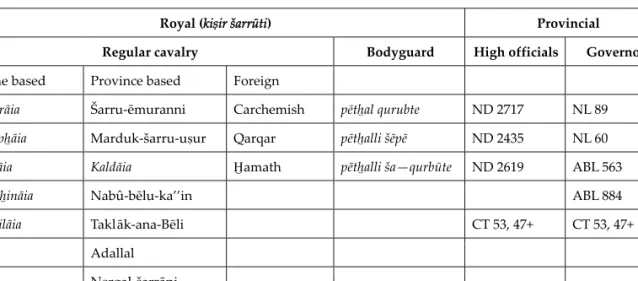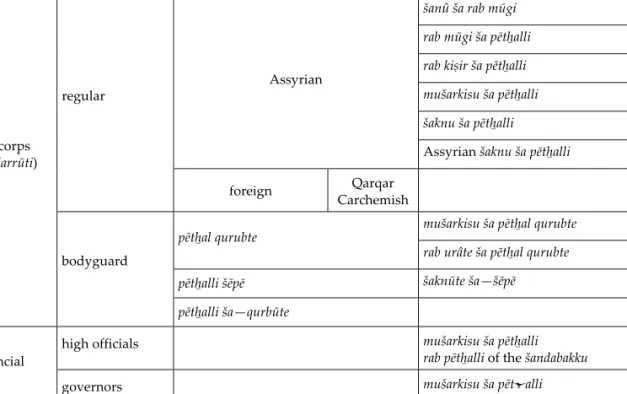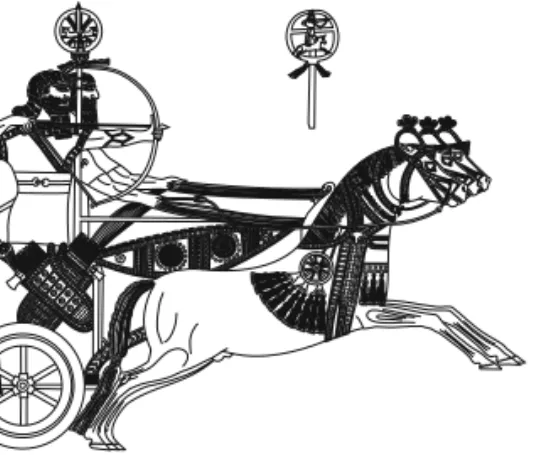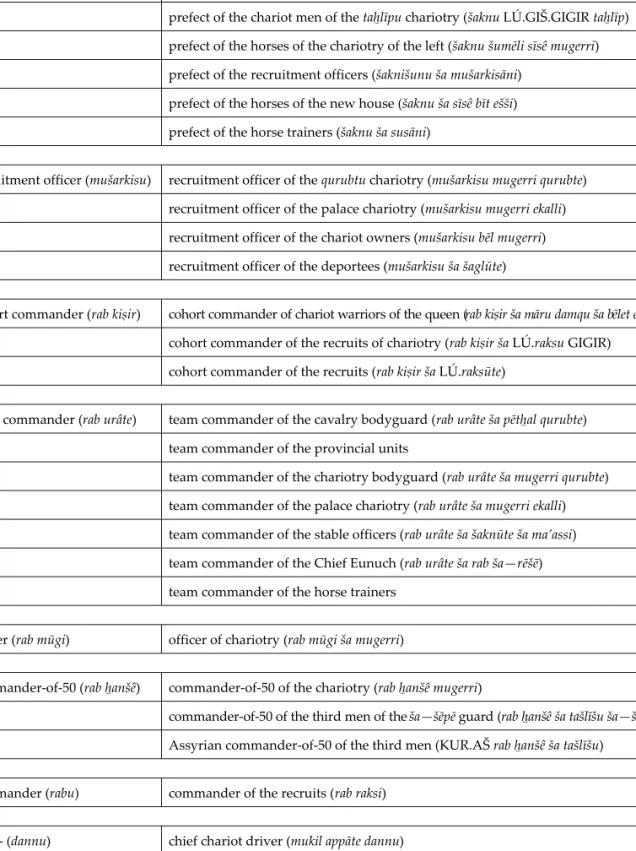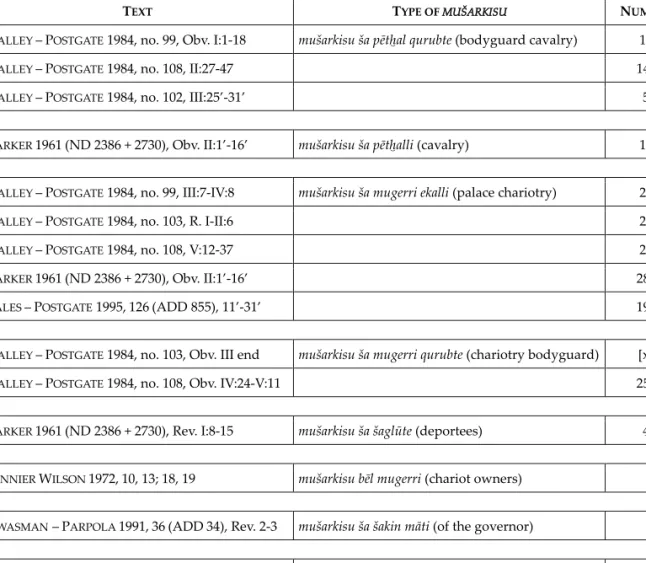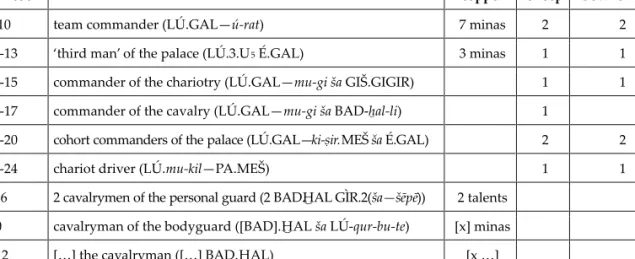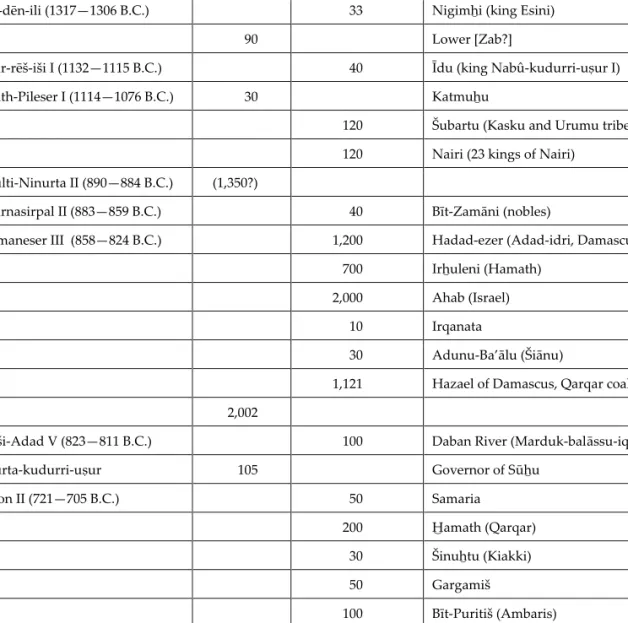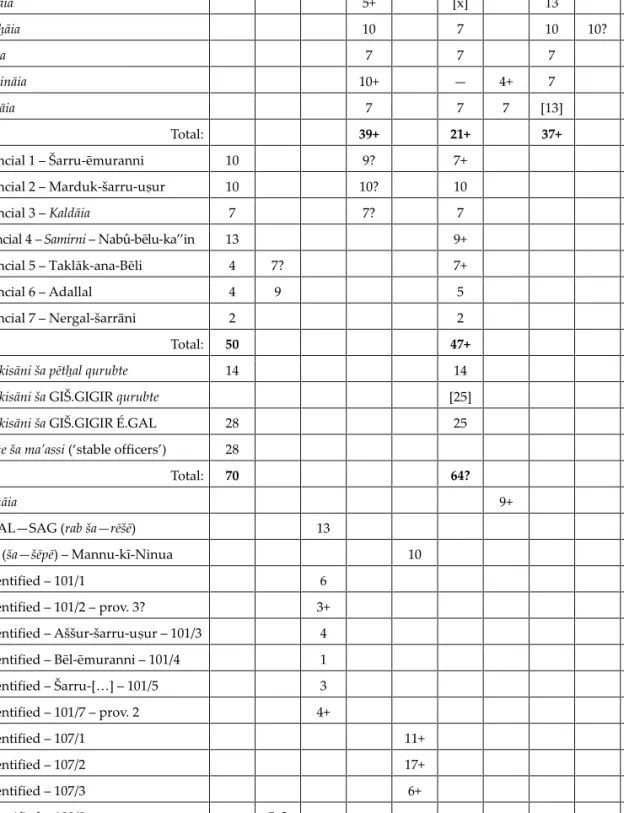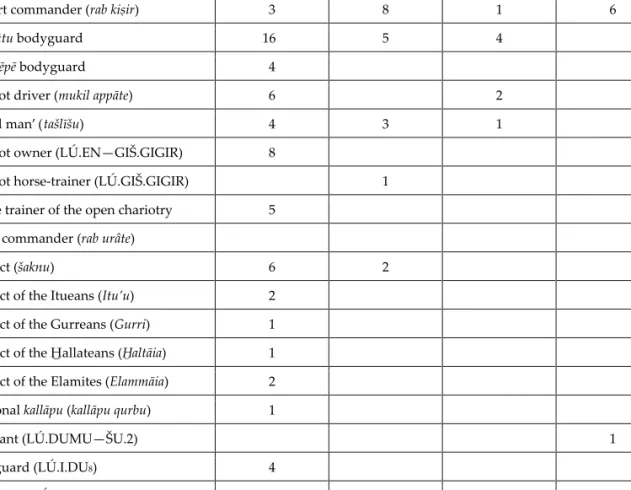Tamás Dezső
THE ASSYRIAN ARMY
I. T HE S TRUCTURE OF THE N EO -A SSYRIAN A RMY 2. CAVALRY AND CHARIOTRY
Antiqua & orientalia
EÖTVÖS UNIVERSITY PRESS EÖTVÖS LORÁND UNIVERSITY
Tamás Dezső THE ASSYRIAN ARMY I/2
To the Memory of my Father
Antiqua et Orientalia 3
Monographs of the Institute of Ancient Studies, Faculty of Humanities, Eötvös Loránd University, Budapest
Assyriologia 8/2
Monographs of the Department of Assyriology and Hebrew, Institute of Ancient Studies, Faculty of Humanities, Eötvös Loránd University, Budapest
Tamás Dezső
THE ASSYRIAN ARMY
I.
T HE S TRUCTURE OF THE
N EO -A SSYRIAN A RMY
as Reconstructed from the Assyrian Palace Reliefs and Cuneiform Sources
2. Cavalry and Chariotry
Budapest, 2012
ISBN 978 963 312 076 7 ISSN 0209 8067
ISSN 2063 1634
www.eotvoskiado.hu Executive publisher: András Hunyady Editorial manager: Júlia Sándor Printed by: Multiszolg Bt.
Layout and cover: Tibor Anders
© Tamás Dezsô, 2012
Drawings: © Tamás Dezsô, 2012
T ABLE OF C ONTENTS
CAVALRY ...13
THE EARLY HISTORY OF THE ASSYRIAN CAVALRY (883—745 B.C.) ...14
The representations (1—4)...14
Cuneiform sources ...16
THE CAVALRY OF THE IMPERIAL PERIOD (745—612 B.C.) ...19
The evolution of the Assyrian cavalry (5—22) ...19
Types of cavalry (regular cavalry – bodyguard cavalry)...21
Lancers (mounted spearmen)...22
Mounted archers ...23
Cavalry bodyguard ...23
(1)Pēt‹alli šēpē (cavalry of the ‘personal guard’) ...28
(2) Pēt‹alli ša—qurbūte(cavalry of the ša—qurbūtebodyguard) ...29
(3) Pēt‹al qurubte (cavalry bodyguard)...29
Home based units of the Assyrian cavalry (ki%ir šarrūti): the ‘city units’...32
Foreign units of the Assyrian cavalry ...32
Cavalry of the high officials and governors ...35
Cavalry officers and other cavalry personnel ...39
Cavalry officers...39
(1) Šaknu(prefect) ...42
(2) Rab mūgi ša—pēt‹alli (cavalry commander) ...42
(3) Rab ki%ir ša—pēt‹alli (cohort commander of the cavalry) ...43
(4) Rab pēt‹alli(cavalry commander) ...43
(5) Mušarkisu(recruitment officer) ...43
Grooms ...44
The use of cavalry ...45
Size of cavalry units ...50
CHARIOTRY ...55
THE EARLY HISTORY OF THE ASSYRIAN CHARIOTRY (1317—745 B.C.) ...56
The representations (23—25)...56
Cuneiform sources ...60
THE CHARIOTRY OF THE IMPERIAL PERIOD (745—612 B.C.)...65
The representations (26—32)...65
Cuneiform sources ...68
TABLE OF CONTENTS
Chariotry units reconstructed from cuneiform sources ...69
Headquarters staff: chariotry element ...69
(1) Ša—šēpēchariotry ...70
(2) Ta‹līpuchariotry...70
(3) Pattūtechariotry ...71
Deportee unit ...72
Chariot owners ...72
Palace chariotry ...74
Chariotry bodyguard ...76
Chariotry of the ša—šēpē guard...76
Chariotry of the bodyguard of the ša—šēpē guard...77
Open chariotry of the bodyguard of the ša—šēpē guard ...78
The ‘city units’ ...78
(1) Aššurāia...78
(2) Arrap‹āia...78
(3) Armāia...79
(4) Arzu‹ināia...79
(5) Arbailāia...80
Foreign units of the Assyrian cavalry of the royal corps (ki%ir šarrūti): The ‘provincial units’ ...81
(1) Unit 1 (Šarru-ēmuranni) ...81
(2) Unit 2 (Marduk-šarru-u%ur) ...82
(3) Unit 3 (Chaldean unit)...83
(4) Unit 4 (Nabû-bēlu-ka’’in) ...83
(5) Unit 5 (Taklāk-ana-Bēli)...84
(6) Unit 6 (Adallal) ...85
(7) Unit 7 (Nergal-šarrāni) ...85
Unit of stable officers ...87
Chariotry of the crown prince...88
Open chariotry of the crown prince ...88
Chariotry of the high officials and governors...88
Foreign chariotry...92
The chariot crew and other chariotry personnel ...93
Mukil appāte (chariot driver) ...93
(1) Chariot driver of the king (mukil appāte ša šarri) ...93
(2) Chariot driver of the crown prince (mukil appāte ša mār šarri)...94
(3) Chariot driver of the queen mother (mukil appāte ummi šarri)...95
(4) Chariot drivers of the high officials ...95
(5) Chariot drivers of governors ...96
(6) Chariot drivers of other officials ...96
(7) Chariot driver of the treasury/storehouse or reserve horses...97
(8) Other types of chariot drivers ...97
Māru damqu (chariot warrior) ...99
(1) Chariot warrior of the king (māru damqu šarri) ...99
(2) Chariot warrior of the […] unit (māru damqu piri […]) ...100
(3) Chariot warrior of the bodyguard (māru damqu ša qurub) ...100
(4) Chariot warrior of the crown prince (māru damqu ša mār šarri)...100
6 ASSYRIAN ARMY • Cavalry and Chariotry
Table of contents
(5) Chariot warrior of the lady of the house (māru damqu ša bēlet bēti) ...100
(6) Chariot warriors of Assyrian officials ...101
(7) Chariot warriors of the gods ...101
Tašlīšu (‘third man,’ shield bearer) ...102
(1) ‘Third man’ of the king (tašlīšu ša šarri) ...103
(2) ‘Third man’ of the crown prince (tašlīšu mār šarri) ...104
(3) ‘Third man’ of the queen mother and the queen (tašlīšu ummi šarri, ša MÍ.É.GAL)...105
(4) ‘Third man’ of high officials ...105
(5) ‘Third man’ of governors and other officials ...105
(6) ‘Third man’ of the left and right ...107
(7) Officers of ‘third men’ ...107
(a) ‘Chief third man’ (tašlīšu dannu)...107
(b) ‘Deputy third man’ (tašlīšu šanû) ...108
(c) ‘Commander-of-50 of the third men’ (rab ‹anšē ša tašlīšāni) ...108
LÚ.GIŠ.GIGIR (susānu/šušānu, ‘chariot man,’ ‘chariot troop,’ ‘chariot horse trainer,’ ‘Pferdeknecht’) ...109
(1) Chariot man / chariot horse trainer (LÚ.GIŠ.GIGIR) ...109
(2) Chariot man / chariot horse trainer of the crown prince (A—MAN) ...114
(3) Chariot man / chariot horse trainer of the open chariotry (DU8.MEŠ) ...114
(4) Chariot man / horse trainer of the open chariotry of the crown prince (GIGIR A—MAN DU8.MEŠ (A—MAN?)) ...115
(5) Chariot man / horse trainer of the ta‹līpuchariotry (šaGIŠ.ta‹-líp) ...115
(6) Chariot man / horse trainer of the reserve horses (na-kám-ti) ...115
(7) Chariot man / horse trainer of the qurbūtubodyguard (qur-bu-[ti]) ...116
(8) Chariot man / horse trainer of theša—šēpēguard (ša—šēpē(GÌR.2)) ...116
(9) Chariot horse trainer of the team commander (ša GAL urât) ...117
(10) Chariot man / horse trainer of eunuchs (šaSAG.MEŠ) ...117
(11) Chariot man / chariot horse trainer of the god Aššur (šaAššur) ...117
Murabbānu (‘horse raiser’) ...117
Raksu (‘recruit’) ...118
(1) Recruit (raksu) ...118
(2) Recruit of the chief eunuch (raksu ša rab ša—rēšē) ...119
(3) Recruit of the chariotry (raksu mugerri)...119
Horse keeper of a god...120
Chariot supervisor ...120
Officers of the chariotry...120
Prefect (šaknu) ...122
(1) Stable officer (lit. prefect of stables, šaknu ša ma’assi) ...122
(2) Prefect of the ta‹līpucharioteers (šaknuLÚ.GIŠ.GIGIR ta‹-líp)...122
(3) Prefect of the horses of the chariotry of the left (šaknu šumēli sīsê mugerri) ...122
(4) Prefect of the recruitment officers (šaknišunu ša mušarkisāni) ...122
(5) Prefect of the horses of the new house (šaknu ša sīsê bīt ešši) ...122
(6) Prefect of the horse trainers (šaknu ša susāni)...122
Recruitment officer (mušarkisu)...123
(1) Recruitment officer of the chariot owners (mušarkisu bēl mugerri) ...127 (2) Recruitment officers of the palace chariotry (mušarkisāni ša mugerri ekalli)127
TABLE OF CONTENTS
(3) Recruitment officer of the chariotry bodyguard (mušarkisu ša mugerri
qurubte) ...127
(4) Recruitment officer of the deportees (mušarkisu ša šaglūte) ...128
(5) Recruitment officer of the governor (mušarkisu ša šakin māti) ...128
Cohort commander (rab ki%ir) ...128
Team commander (rab urâte) ...130
(1) Team commander of the cavalry bodyguard (pēt‹al qurubte) ...130
(2) Team commander of the provincial units ...131
(3) Team commander of the chariotry bodyguard (rab urâte ša mugerri qurubte) ...131
(4) Team commander of the palace chariotry (rab urâte ša mugerri ekalli) ...131
(5) Team commander of the stable officers (rab urâte ša šaknūte ša ma’assi)...131
(6) Team commander of the Chief Eunuch (rab urâte ša rab ša—rēšē)...131
(7) Team commander of the horse trainers ...132
Chariotry or cavalry commander (rab mūgi) ...132
(1)Rab mūgi of the chariotry (LÚ.GAL—mu-gi šaGIŠ.GIGIR) ...134
(2) Rab mūgiof the cavalry (LÚ.GAL—mu-gi šaBAD-‹al-li) ...135
Commander-of-50 (rab ‹anšê) ...135
(1) Commander-of-50 of the chariotry (rab50 GIŠ.GIGIR.MEŠ) ...135
(2) Commander-of-50 of the ‘third men’ (rab50 tašlīšāni)...135
(3) Assyrian commander-of-50 of the ‘third men’ (Aššurāia rab50ša tašlīšāni) ...135
(4) Commander-of-50 of the ‘third men’ of the ša-šēpēguard (rab50 ša tašlīšāni ša—šēpē) ...136
The size of the chariotry units ...136
(1) Reconstruction of the size of chariotry units using the number of chariots ...136
(2) Reconstruction of the size of chariotry units using the number of officers ...138
(3) Reconstruction of the size of chariotry units using the number of soldiers...143
(4) Reconstruction of the size of chariotry units using the number of horses ...144
SUMMARY: THE DEVELOPMENT OF THE NEO-ASSYRIAN ARMY...147
Assurnasirpal II (883—859 B.C.) ...147
Shalmaneser III (858—824 B.C.) ...150
Tiglath-Pileser III (745—727 B.C.)...152
Sargon II (721—705 B.C.) ...154
Sennacherib (704—681 B.C.) ...156
Esarhaddon (680—669 B.C.) ...159
Assurbanipal (668—631 B.C.) ...160
8 ASSYRIAN ARMY • Cavalry and Chariotry
Table of contents
CHARTS ...165
Chart 1 Equestrian army of Sargon II ...165
Chart 2 Officers and other military personnel of the Rēmanni-Adad archive (671—660 B.C.) ...166
Chart 3 Officers and other military personnel of the Šumma-ilāni archive (709—680 B.C.) ...184
Chart 4 Number of chariots and horses mentioned in the Assyrian royal inscriptions...186
Chart 5 Chariot drivers (mukil appāte) ...192
Chart 6 Chariot warriors (māru damqu) ...194
Chart 7 ‘ Third men’ (tašlīšu) ...196
Chart 8 Chariot men / chariot horse trainers (LÚ.GIŠ.GIGIR) and chariot owners (bēl mugerri) ...198
Chart 9 The stucture of texts CTN III, 99, 102, 103, 108, 111 and the reconstruction of Assyrian army units ...202
Chart 10 The reconstruction of equestrian units of two texts of Nimrud Horse Lists ...204
Chart 11 Reconstruction of the Assyrian army – Infantry (ratio of the different arms represented on the palace reliefs)...206
Chart 12 Reconstruction of the Assyrian army – Cavalry and Chariotry (ratio of the different arms represented on the palace reliefs)...208
Chart 13 Reconstruction of the Assyrian army (ratio of the different arms represented on the palace reliefs)...208
BIBLIOGRAPHY ...211
INDEX ...241
PLATES ...253
LIST OF FIGURES Fig. 1. Reconstruction of the Assyrian cavalry of the Sargonides ...38
Fig. 2. Officers of the Assyrian cavalry ...44
Fig. 3. Officers of the chariotry...121
Fig. 4. Number of recruitment officers mentioned in cuneiform sources ...126
Fig. 5. List of tribute distributed to equestrian officers at court (FALES – POSTGATE 1995, 36) ..134
Fig. 6. Numbers of chariots mentioned in Assyrian royal inscriptions ...137
Fig. 7. Number of equestrian officers (cavalry and chariotry) listed in CTN III, 99 ...139
Fig. 8. Number of equestrian officers (cavalry and chariotry) listed in the Nimrud Horse Lists ...140
Fig. 9. The division of officers concerning ADD 857 ...160
Fig. 10. Structure of the armies of Assyrian kings...163
„Now the creature that I have envied most is, I think, the Centaur (if any such being ever existed), able to reason with a man’s intelligence and to manufacture with his hands what he needed, while he possessed the fleetness and strength of a horse so as to overtake whatever ran before him and to knock down whatever stood in his way. Well, all his advantages I combine in myself by becoming a horseman.
At any rate, I shall be able to take forethought for everything with my human mind, I shall carry my weapons with my hands, I shall pursue with my horse and overthrow my opponent by the rush of my steed, but I shall not be bound fast to him in one growth, like the Centaurs.”
Chrysantas in Xenophon’s Cyropaedia,IV. iii. 17-18 (W. Miller, transl., Xenophon, Cyropaedia, The Loeb Classical Library, London, 1914)
ASSYRIAN ARMY • Cavalry and Chariotry 11
C AVALRY
One of the most important chapters in the military history of Assyria and the Near East is the development of the cavalry as an independent arm of the army.1Although the art of horse riding was known as early as the beginning of the 2ndmillennium B.C.2the cavalry as an independent, regular arm of an army can be identified for the first time in Assyria during the early 1stmillennium B.C. In addition to the earlier Near Eastern use of horsemen as ‘mounted messengers,’ the first depictions of the cavalry as a fighting arm appear in the palace reliefs of Assurnasirpal II (883—
859 B.C.). It is obvious that the first Assyrian (and Near Eastern) cavalry units were not established by Assurnasirpal II, and that other Near Eastern peoples had cavalry units at that time. The horse-breeding peoples of the Zagros and Armenian Mountains certainly used cavalry units among their troops. The earliest appearance of this foreign cavalry is in the palace reliefs of Assurnasirpal II, as fleeing horsemen pursued by the Assyrian chariotry.3In this scene an Assyrian chariot (perhaps belonging to the king himself) is pressing six enemy horsemen equipped with bows and swords. It is not known exactly where horsemanship and the cavalry developed, but it probably happened somewhere in the triangle formed by the Armenian Mountains, the Zagros Mountains and Assyria. But it was in Assyria that, in the course of its development, the cavalry became an independent arm of the army.
The Assyrians developed the various uses of the cavalry on which the cavalry traditions of later ages were based. The cavalry was divided into lancers and mounted archers at the latest during the reign of Sennacherib, and the armoured cavalryman appeared in the Assyrian army as well. All the important ways of using the cavalry appear in the Assyrian palace reliefs. What is more, the same sculptures show how the cavalry overshadowed and finally replaced the chariotry, which gradually became an obsolete and redundant part of the Assyrian army. The role played by the Assyrian cavalry in the general development of the military use of horsemanship has not been fully recognised. Only a few articles on this topic – based on cuneiform sources4or on the depictions of cavalry in palace reliefs5– have been published. These studies are, however, highly specialized, and the general summaries of the military history of the Near East still do not lay proper stress on the cavalry developments mentioned above.
1FALES2010B, 126-130.
2RITTIG1994, 156-160.
3MEUSZYŃSKI1981, Taf. 3, B-27; Nimrud, Northwest Palace, London, British Museum, WA 124559.
4DALLEY– POSTGATE1984A, 27-47; DALLEY1985, 31-48.
5NOBLE1990, 61-68; DEZSŐ2006A, 112-118.
Table of Contents
The Early History of the Assyrian Cavalry (883—745 B.C.)
The representations (1—4)
The Assyrian cavalry is represented in the palace reliefs of Assurnasirpal II in two contexts. In the first the cavalryman is hunting (escorting the king) (Plate 1, 1).
It is interesting that there are two horses depicted side by side in this scene, and the cavalryman is riding the horse which is partially covered by the other one, and holding the reins of both. The riderless horse is probably the reserve horse of the royal chariot travelling in front of them. The horseman wears the well known pointed helmet. There is a rounded (bronze) shield fastened to his back. He is equipped with a bow, a quiver, a sword and a tasselled lance with which he is spearing a wild bull.6 In another bull-hunting scene he is escorting the royal chariot.7A similar horseman appears in a third sculpture, in which he is leading the reserve horse of the royal chariot (Plate 1, 2).8
The character of the second context is clearly military, and shows the ways in which the early Assyrian cavalry could be deployed. There are two cavalrymen fighting in a pair in one of the palace reliefs of Assurnasirpal II. One of them – an archer wearing a pointed helmet – is using his bow, while the other – equipped with rounded bronze shield, sword (and lance?) and wearing a hemispherical helmet with earflaps – holds the reins of both horses (Plate 2, 3, 4).9The garments of the archers are decorated, they have no armour, only a wide belt, probably made of bronze.
In this sculpture two pairs of such cavalrymen are chasing the fleeing enemy.
The similarity to chariot warfare is obvious: the chariot warrior (the archer) uses his weapon, while the chariot driver/’third man’ (shield-bearer) holds the reins and/or protects him with his shield. At this point one of the most important reasons for the development of the cavalry can be detected. Assyrian chariots were pulled by two, three or even four horses, and ideally had a crew of three:10the chariot warrior, the chariot driver, and the ‘third man’ (shield-bearer). The warrior – horse ratio in this case was 1:2 or 1:3. The value of the shield-bearing ‘third man’ in battle is questionable. In close combat, and only then, he might have played an active part in the fighting.
This 1:2 or 1:3 ratio of warriors to horses was uneconomical, because horses were very expensive (considering not only their acquisition and breeding, but breaking them in to the chariot, and CAVALRY
6LAYARD1853B, pl. 32.
7LAYARD1853B, pl. 11.
8LAYARD1853B, pl. 21.
9LAYARD1853B, pl. 26.
10For a detailed study seechapter Chariotry.
14 ASSYRIAN ARMY • Cavalry and Chariotry
Table of Contents
continuous exercise as well). Furthermore if a chariot horse was wounded in battle, the other horses and the chariot crew could easily become useless. Similarly, if the chariot warrior was wounded, the chariot (with its horses and the remaining members of the crew) could easily lose most of its fighting efficiency.11In contrast, in the case of cavalry the warrior – horse ratio was the ideal 1:1. This was the most economical way of using horses. Moreover there was no need for the expensive chariot itself, which was probably difficult to repair. In addition to this, the cavalry was a much more flexible arm: it could be deployed on difficult terrain (muddy ground, rivers, watercourses, hilly and mountainous country, forest, etc.), where the chariot was useless.
The palace reliefs of Assurnasirpal II show a transitional phase in the evolution of the cavalry, the gradual abandonment of the chariotry, and the advent of the independent cavalry. There is still a shield-bearing horseman beside the mounted archer, but it is obvious that this shield- bearing lancer’s fighting efficiency was of full value. They are effectively two cavalrymen, probably with the same fighting value and with the possibility of fighting independently of one another. Moreover, in close combat they ideally complement each other.
The same picture is revealed from the two Balawat Gates (palace and Mamu Temple) of Assurnasirpal II. Cavalrymen are shown fighting enemy infantry,12and marching behind chariots or escorting the royal chariot (leading spare horse).13
The Balawat Gates of Shalmaneser III (858—824 B.C.) display several possible uses of the cavalry.14There are galloping cavalrymen riding in pairs, alternating with chariots represented in a battle scene, in the act of trampling the fleeing enemy infantry. Both cavalrymen wear pointed helmets. One of them is shooting with his bow, while the other is protecting him with his rounded (bronze) shield.15The same scene is repeated on another band, but the lancer riding side by side with the mounted archer is spearing an enemy infantryman with his lance.16 Further cavalrymen are represented riding behind chariots. In this scene the cavalrymen are depicted in pairs and alone.
Those who are riding alone (both archers and shield-bearing lancers) are leading reserve horses.17 The next scene shows cavalrymen (equipped again with bows and lances) crossing a river. Each of them is taking a reserve horse with him.18One interesting scene shows a cavalryman equipped with spiked bronze shield, lance and bow, who is leading a reserve horse behind the royal chariot.19 He is probably a high ranking officer or a member of the cavalry bodyguard unit.
The Early History of the Assyrian Cavalry
11In this case the ’third man’ could probably replace the chariot warrior to some extent.
12CURTIS– TALLIS2008, Figs. 10 (Bīt-Adini, fighting behind Assyrian chariots against Aramean archers), 12 (›atti, fighting behind Assyrian chariotry (1 pair of cavalrymen)), 60 (Mt. Urina, fighting against ‘Urartian’ infantry (7 pairs of cavalrymen)), 70 (unknown campaign, fighting against enemy infantry (1 pair + 1 cavalryman), 86 (Bīt-Adini, attacking behind royal chariot (2 pairs), attacking the city Bīt-Adini (1 + 1).
13CURTIS– TALLIS2008, Figs. 8 (Town Sarugu, 1 cavalryman), 10 (Bīt-Adini, 1 cavalryman), 24 (›atti, 1 cavalryman), 36 (›atti, 1 cavalryman), 76 (Bīt-Adini, 1 cavalryman).
14For a detailed study of the cavalry shown on the Balawat Gates seeSCHACHNER2007, 159-160, Abbs. 92-95, Tab. 43 (6.3.4.2 Reiter).
15BARNETT1960, 167.
16BARNETT1960, 147, 167.
17BARNETT1960, 143.
18BARNETT1960, 161.
19BARNETT1960, 161.
Cuneiform sources
The first Assyrian cavalry units appear in the royal inscriptions of Tukulti-Ninurta II (890—884 B.C.).20Somewhat later, in 880 B.C. when Assurnasirpal II (883—859 B.C.) led a campaign to Zamua, he placed his cavalry (pit-‹al-lu) and his kallāpuinfantry (LÚ.kal-la-pu) in ambush next to the city of Parsindu and killed 50 soldiers of Ameka, king of the city of Zamru in the plain.21 From Zamru he took with him the same cavalry and kallāpuinfantry and marched to the cities of Ata, king of the city of Arzizu.22This campaign shows the cavalry being used in various ways:
to lay an ambush and to move quickly. It is important to note that the cavalry became a regular part of the Assyrian army on campaign. Assurnasirpal II mentioned it in a standard context: “I took with me strong chariots, cavalry (and) crack troops.”23 The reserves of horses were so important that the control of horse-breeding countries and territories became a strategic goal of campaigns. On one of his campaigns Assurnasirpal II – because horses were not constantly brought to him and he became angry – led his army to the cities of Marira and ›al‹alauš.24In 879 B.C. he led a campaign to Katmu‹i and Nairi and according to his royal inscriptions he crossed the Tigris with his strong chariots, cavalry, and infantry by means of a pontoon bridge.
In 878 B.C. he besieged and captured Sūru, the fortified city of Kudurru, governor of the land of Sū‹u. In the city he captured 50 cavalrymen, the troops of Nabû-apla-iddina, king of Karduniaš, and his brother Zabdānu with his 3,000 fighting men.25In 877 B.C., when he led a campaign to the West, to the Mountains of Lebanon, he took with him the cavalry (with chariotry and infantry) units of the North Syrian states which surrendered to him.26Bīt-Ba‹iāni, Adad-‘ime, king of Azallu, A‹ūnî, king of Bīt-Adini, Carchemish, Lubarna, king of Pattina. This is the first known occasion when foreign cavalry units were drafted into the Assyrian forces. Assurnasirpal II, however, probably did not incorporate them into the Assyrian army proper, but took them on as auxiliary units.
In spite of the fact that the descriptions of campaigns in the royal inscriptions of Shalmaneser III (858—824 B.C.) still began with the standard formula: “I mustered my chariots and troops”27 the cavalry was becoming increasingly important in Assyrians warfare. In 856 B.C., when Shalmaneser III defeated Arame, king of Urartu, in a mountain battle, he brought back from the mountain Arame’s chariots, cavalry (pit-‹al-lu-šu) and horses.28 The inscriptions mention numerous cavalry, which shows that Urartu was a primary horse-breeding country and in the mountainous terrain they probably used far more cavalry than chariotry. In the next year, 855 B.C., the Assyrian king led a campaign against A‹ūnî, king of Bīt-Adini. In one of his reports the king mentioned that after the siege of Mount Šitamrat he brought down from the mountain CAVALRY
20GRAYSON1991, A.0.100.5, 37: pit-‹al-li.
21GRAYSON1991, A.0.101.1, II:70-71; A.0.101.17, III:84-85.
22GRAYSON1991, A.0.101.1, II:72.
23Mount Simaki: GRAYSON1991, A.0.101.1, II:52-54 (GIŠ.GIGIR.MEŠ KAL-tu pit-‹al-luSAG.KAL-su) and A.0.101.17, III:36-37;
city Tuš‹an: GRAYSON1991, A.0.101.1, II:103-104 and A.0.101.17, IV:61-62.
24GRAYSON1991, A.0.101.18, 3’-6’.
25GRAYSON1991, A.0.101.1, III:19-20.
26GRAYSON1991, A.0.101.1, III:58-77.
27GIŠ.GIGIR.MEŠ ÉRIN.›I.A.MEŠ ad-ki. GRAYSON1996, A.0.102.1, 15; A.0.102.2, I:15; A.0.102.6, I:29; A.0.102.11, 13’-18a’;
A.0.102.14, 141; A.0.102.16, 7-8, 228’.
28GRAYSON1996, A.0.102.2, 51; A.0.102.28, 40-41; numerous cavalry (pit-‹al-lu›I.A.MEŠ): A.0.102.5, III:2; A.0.102.6, I:65-68.
16 ASSYRIAN ARMY • Cavalry and Chariotry
Table of Contents
A‹ūnî with his troops, chariots and cavalry.29In 853 B.C. the Assyrians led the first campaign against the coalition of the twelve kings and fought a battle near Qarqar. ›adad-ezer (Adad-idri), king of Damascus, mustered 1,200 chariots, 1,200 cavalry and 20,000 troops, while Ir‹uleni, king of ›amath, brought 700 chariots, 700 cavalry and 10,000 troops.30These numbers show that at that time the larger North Syrian states could deploy relatively large numbers of cavalry. After the battle the Assyrians captured the remnants of the coalition army, including the cavalry.31In 849 B.C. the Assyrian king fought the coalition army of the 12 kings again and captured their chariots and cavalry in battle.32In the next year, 848 B.C., the Assyrians fought for the third time against the coalition army of the 12 kings, defeated them, and captured their chariotry and cavalry.33 In 845 B.C. the Assyrians defeated the coalition army of the 12 kings a fourth time, and again destroyed their chariotry and cavalry.34In 843 B.C. Marduk-mudammiq, king of Namri, sent his numerous cavalry (pit-‹al-lu-šu ›I.A.MEŠ) against the Assyrian army in a battle.35 Marduk- mudammiq drew up a battle line opposite the Assyrians at the River Namritu, but suffered defeat, and Shalmaneser III took his cavalry from him. In 841 B.C. the Assyrian king led a campaign to Damascus again. At that time ›azael was the king of Damascus; he fortified Mount Saniru, a mountain peak in front of Mount Lebanon. The Assyrians defeated them and put to the sword 16,000 Damascene fighting men, and took from ›azael 1,121 chariots and 470 cavalry.36In 832 B.C. the Assyrian king sent his Commander-in-Chief Daiiān-Aššur to Urartu. The Commander- in-Chief defeated Sēduru (Sarduri I), king of Urartu and took his numerous cavalry from him.37 Once again Urartu appears to have been a horse-breeding country which used large numbers of cavalry, though it is not known exactly how many. Shalmaneser III, however, boasted that he had horses for 2,002 chariots and equipped a further 5,542 horsemen for the service of his country.38This number – if these 5,542 cavalrymen were all under arms at the same time – is the largest known, and probably included the auxiliary cavalry units of the vassal kings as well.
His successor, Šamši-Adad V, (823—811 B.C.) mentions in his royal inscriptions that on his third campaign he captured 140 horsemen of the Median ›anasiruka as well,39and on his fourth campaign when he defeated Marduk-balāssu-iqbî, the king of Karduniaš, in the battle fought by the Daban River before the city of Dūr-Papsukkal, he captured 100 chariots and 200 horsemen from his enemy.40 It is known from one of his fragmentary inscriptions that during his fourth campaign he pursued an unfortunately unknown army, massacred 650 soldiers, and captured 30 cavalry and one chariot from them.41On his fifth campaign he led his army to Karduniaš a second time, and in the battle fought at the gate of Nēmetti-šarri he captured the chariots and cavalry of Marduk-balāssu-iqbî.42
The Early History of the Assyrian Cavalry
29GRAYSON1996, A.0.102.2, II:73-74.
30GRAYSON1996, A.0.102.2, II: 90-95.
31GRAYSON1996, A.0.102.2, II:101-102; A.0.102.6, II:30-32; A.0.102.8, 18’-19’; A.0.102.10, II:22-25; A.0.102.14, 54-66; A.0.102.16, 35-37; A.0.102.23, 21-27.
32GRAYSON1996, A.0.102.6, II:65-66; A.0.102.8, 34’-35’.
33GRAYSON1996, A.0.102.6, III:8-10; A.0.102.8, 38’-39’.
34GRAYSON1996, A.0.102.6, III:30-32; A.0.102.8, 44’-47’; A.0.102.10, III:15-16; A.0.102.16, 87’-95’; A.0.102.24, 14b-17.
35GRAYSON1996, A.0.102.6, IV:7-12.
36GRAYSON1996, A.0.102.8, 1’’-13’’; A.0.102.10, III:51-52; A.0.102.12, 21-24; A.0.102.14, 97-99; A.0.102.16, 122-137.
37GRAYSON1996, A.0.102.16, 228’-237’.
38GRAYSON1996, A.0.102.6, IV:47-48; A.0.102.10, left edge 2 (5242); A.0.102.11, left edge II:1-2; A.0.102.16, 348’.
39GRAYSON1996, A.0.103.1, III:27b-36.
40GRAYSON1996, A.0.103.1, IV:37-45.
41GRAYSON1996, A.0.103.2, III:11’-12’.
42GRAYSON1996, A.0.103.2, III:32’. The same events were repeated in a ‘letter from a god’: A.0.103.4, 1’-15’.
During the reign of Adad-nērārī III (810—783 B.C.) a Tell Halaf text lists 6 cavalrymen of the turtānu.43In a ‘letter to the god,’ written probably during the reign of Shalmaneser IV (782—773 B.C.),44the standard closing formula about Assyrian casualties appears: “[1 charioteer, two]
cavalrymen, (and) [three kallāpusoldiers] were killed.”45 The earliest known appearance of cavalrymen in the cuneiform records is also in the early 8thcentury B.C., in 788 B.C.46
As the written sources show, in the early 9thcentury B.C. the cavalry was used outside Assyria mainly in the mountainous regions to the North and East, and in North Syria. By the late 9th century B.C., however, it had become widespread throughout the Near East.
CAVALRY
43FRIEDRICH ET AL. 1940, 25:7-8. Seefurthermore the 18 teams of cavalry of the governor (18 ú-ra-a-ti pet-‹al-lu šaLÚ.EN—NAM) from the same archive (38:rev. 4-5). A further text also mentions 15 teams of horses to be collected to the Commander-in-Chief (3:3-7).
44GRAYSON1996, A.0.105, which can be dated probably to 780 B.C., to the eponym year of Šamši-ilu, the turtānu.
45GRAYSON1996, A.0.105, Rev. 1’-4’.
46Marduk-uballi#ša pet-‹al-li, POSTGATE1973, 94 (ND 254), Rev. 8-9. This wittness list shows that he was a professional cavalrymen.
18 ASSYRIAN ARMY • Cavalry and Chariotry
The Cavalry of the Imperial Period (745—612 B.C.)
The evolution of the Assyrian cavalry (5—22)
The palace reliefs of Tiglath-Pileser III (745—727 B.C.) show both unarmoured and armoured cavalrymen.
The unarmoured47cavalrymen (Plate 3, 5) are depicted as a pair, chasing an Arab tribesman who is fleeing on a camel. The depiction of cavalrymen in pairs in this case, however, does not mean that they fought in pairs, but that in the iconographical concept of the sculptures the masses of cavalrymen fighting a battle (in formation) were represented as pairs. They wear pointed helmets and tunics (with a loosely fitting kilt reaching to the knee). The horses are unarmoured, their trappings are decorated. The most important weapon of the cavalrymen is the cavalry lance, which they are using to spear the enemy from the overarm position – similarly to an infantry spear.
Their auxiliary weapon is the sword. A fragmentary sculpture of Tiglath-Pileser III shows a cavalry battle. Two Assyrian cavalrymen are spearing a wounded enemy horseman, whose crested helmet may indicate his Urartian origin.48 It is known from the royal inscriptions of Tiglath-Pileser III that in his 3rdpalû(743 B.C.) in the territory of Kummu‹, between Kištan and
›alpi, the Assyrian army defeated the coalition army of Mati’-ilu, king of Arpad, Sarduri II, king of Urartu, Sulumal, king of Meliddu, and Tar‹ularu, king of Gurgum. The Assyrian cavalry chased the fleeing Urartian king to his capital, Turušpâ, and defeated the Urartians before the gates.49It is possible that this scene depicts an episode of this campaign.
The first armoured lancers appeared in the sculptures of Tiglath-Pileser III (Plate 3, 6). Their equipment differs from the equipment of the unarmoured cavalrymen in their scale armour, and their loosely fitting armoured kilt reaching to the knee. In the palace reliefs of Tiglath-Pileser III all the cavalrymen are barefoot. They wear pointed helmets with earflaps. They are using their long cavalry lances to spear an enemy horseman from the overarm position. Unfortunately the front part of the figure of the enemy horseman is missing, so it is impossible to identify his nationality.
In the palace reliefs of Sargon II (721—705 B.C.) the number of depicted cavalrymen rises significantly (9.4 % of the represented soldiers are cavalrymen, Chart 12).50The large number of
47BARNETT– FALKNER1962, pls. XIII-XIV, Ser. A. Lower Reg. Slab 1b, Or. Dr. Central III. It must be mentioned that the original drawing by A.H. Layard shows unarmoured cavalrymen, but in the photograph the outlines of the scales of a suit of scale armour can probably be seen.
48BARNETT– FALKNER1962, pls. LXIV-LXV.
49TADMOR1994, Ann. 17, Stele IB: 21’-43’, Summ. 1: 20-23.
50As Chart 12shows, the eqivalent figure is 4.4 % in the sculptures of Tiglath-Pileser III, 13.3 % in the sculptures of Sennacherib, and 8.6 % in the sculptures of Assurbanipal.
Table of Contents
cuneiform sources proves that this high percentage is not merely a distortion originating in the iconographical concept of the sculptures (seebelow).
The cavalry in the palace reliefs of Sargon II are usually depicted in pairs. The trappings of their unarmoured horses are decorated (Plate 4, 8; Plate 5, 9, 10). The cavalrymen, too, are unarmoured: they wear pointed helmets and tunics ending in a loosely fitting kilt reaching to the knee. The saddle was unknown at that time, and the Assyrians used animal skins as a kind of
‘saddle cloth.’ Their main offensive weapon is the long cavalry lance, but they are equipped with bows, quivers and swords as well. An important development in the evolution of the cavalry was that the cavalrymen wielded their lances not only from the upper hand position, but from the lower hand position as well (Plate 5, 9, 10). The long cavalry lance, which was designed for thrusting, was to emerge later from this use. Since the cavalrymen are equipped with a lance and bow as well, they may have been a kind of ‘regular cavalry’ intended for universal purposes.
The Til-Barsip wall paintings show the same cavalry (Plate 4, 7). Their equipment is the same as the equipment of the cavalrymen of Sargon II: it consists of a long cavalry lance, a bow and quiver, and a sword. They did not wear armour, only pointed helmets. It is interesting that all the horse riders represented in the wall paintings are equipped with whips as well. However, the most important thing is the appearance of the counterweight at the end of their long cavalry lances, which made the weapons easier to handle, and provided a possibility to distinguish the cavalry units from each other (by the colour of the tassel; for the other possibility, the shape and colour of the horses’ crests seebelow).
The proportion of the cavalry in the sculptures of Sennacherib (704—681 B.C.) is also high.
The 232 represented cavalrymen make up 13.3 % of all the soldiers depicted on the sculptures (Chart 12). One of the reasons for this high ratio is that in the more than 800 known sculptures and sculpture fragments there is not a single chariot except for the royal chariot and a few ceremonial chariots (seebelow). This probably means that the chariotry was overshadowed by the cavalry, who were depicted in large numbers, and whose presence became permanent (Plate 7, 13, 14; Plate 8, 15, 16). The horses are unarmoured, the cavalrymen always wear pointed helmets and scale armour. The kilt of their garment became tighter, and from that time on the Assyrian cavalrymen wore the characteristic military boots. In the palace reliefs three types of Assyrian cavalrymen can be distinguished. Their equipment differs only in their weaponry, but not in their armour or horse harness. The weaponry of the first type consisted of a sword, a lance, a bow, and a combined bow case and quiver, of the second type of a long cavalry lance,51and the third type of a bow. This probably indicates the separation of the well-equipped cavalry bodyguard, the regular cavalry lancer, and the regular mounted archer (seelater). All these changes, and the standardization of the arms and armour of the heavy infantry and cavalry, can be linked to a possible army reform of Sennacherib.52
CAVALRY
51Assyrian lancers of the 8th—7thcenturies B.C. never carried shields. However, – judging from the cavalry depictions of Urartian bronze helmets – their Urartian counterparts were equipped with an Assyrian-type pointed helmet, a rounded bronze shield, and two spears. For the depictions and a detailed bibliography seeDEZSŐ2001, nos. 91, 93, 94, 95 (all of the depictions from Karmir Blur), no. 98 (from unknown provenance).
52Seefor example the texts listing the ‘new corps of Sennacherib:’ FALES– POSTGATE1992, 3 (ADD 853, obv. I:6’), 4 (ADD 854, obv. I:1’-rev. II:6’). The high-ranking officials (and their troops) listed in these documents were assigned to Sennacherib. These texts mention him without a royal title, which means that he was probably the crown prince at that time. From the reign of Sargon II or Sennacherib high ranking military officers at the royal court were assigned not only to the king and the Chief Eunuch (the commander of the ki%ir šarrūti), but to the crown prince and the queen mother as well. Seefor example FALES– POSTGATE1992, 5 (ADD 857), and Summary: The development of the Assyrian army.
20 ASSYRIAN ARMY • Cavalry and Chariotry
The evolution of the Assyrian cavalry reached its highest point during the reign of Assurbanipal (668—631 B.C.). The most important result of this evolution was the appearance of horse armour. In the palace reliefs of Assurbanipal the horses are protected by thick leather armour. The armour covered the neck and body of the horse, and hung down to its hind legs. The sculptures show clearly that the armour was made of separate pieces, which were fastened together with hooks on the neck, breast, back and croup of the horse (Plate 9, 17, 18; Plate 10, 19, 20; Plate 11, 21, 22), thus only the forehead and the legs were left free. Two types of horse-armour can be reconstructed from the sculptures: the first type (Plate 9, 18) partly covers the breast of the horse and leaves more freedom of movement for its forelegs.53The second type (Plate 9, 17) covers the breast of the animal much more fully, hanging down like a pectoral. This type appears primarily on chariot horses54but was used on cavalry horses as well.55The small areas left free by the horse armour offered much smaller and more difficult targets for the enemy’s spears and arrows than the breast and side of an unarmoured horse. Furthermore, the horse’s forehead could have been protected by a bronze plate. The use of horse armour greatly improved the efficiency of the cavalry as an arm as well, since it reduced losses in horses, increased the safety of the cavalry in battle, and improved the supply of horses during campaigns.
The cavalry lancers (Plate 9, 17, 18) and archers (Plate 10, 19, 20) are separated in the representational tradition of the sculptures of Assurbanipal as well. The armour of the cavalrymen is the same as in the palace reliefs of Sennacherib: they wore pointed helmets, which – since the reign of Sennacherib – could have been made of iron as well.56Their upper body was covered with scale armour, which could have been made of iron from the early 8thcentury B.C. This scale armour covered part of the groin and waist as well. They wore Assyrian military boots.
It must be mentioned that the contemporary Urartian depictions of cavalrymen show the strong influence of Assyrian cavalry equipment (pointed helmets, scale armour, and lances). This type of galloping cavalryman is shown in two registers, for example on the side of an 8thcentury B.C.
Urartian bronze helmet.57Further incised representations on Urartian bronze helmets, however, show cavalrymen wearing pointed helmets, equipped with lances, but with their upper body covered by a rounded bronze shield.58As has been mentioned 9thcentury B.C. Assyrian cavalry lancers depicted in the sculptures of Assurnasirpal II were also equipped with rounded bronze shields but the shield is completely missing from later depictions of Assyrian cavalrymen.
Types of cavalry (regular cavalry – bodyguard cavalry)
As attested by the palace reliefs of the period, the Assyrian cavalry was relatively homogeneous.
In the palace reliefs of Tiglath-Pileser III (745—727 B.C.) cavalrymen both of a kind of regular or light cavalry (Plate 3, 5) and of the heavy cavalry (Plate 3, 6) appear. These sculptures show that The Cavalry of the Imperial Period
53BARNETT– BLEIBTREU– TURNER1998, nos. 278, 282, 313, 382 and 383 (the version with hooks), 384, 385, 388(?), 399(?).
54BARNETT– BLEIBTREU– TURNER1998, nos. 384 (with hooks), 388.
55BARNETT– BLEIBTREU– TURNER1998, nos. 392, 394.
56DEZSŐ– CURTIS1991, 105-126, DEZSŐ2001, 33-36.
57KELLNER1980, pls. VII-IX; DEZSŐ2001, Cat. no. 100, private collection, galvano copy: Munich, Archäologische Staatssammlung, PS 1971/1782a.
58DEZSŐ2001, Cat. nos. 91-97 (Erevan), 98 (Karlsruhe), 99 (Gaziantep).
Table of Contents
the separation of these two types of cavalrymen had taken place at the latest during the reign of Tiglath-Pileser III. The reign of Sargon II (721—705 B.C.) brought the standardization of cavalry equipment: only regular cavalrymen are shown (Plate 4, 8; Plate 5, 9, 10). They do not wear armour, but only the characteristic Assyrian pointed helmet. Their weaponry consists of a lance, a bow and quiver, and a sword.
The most important changes occurred, however, during the reigns of Sennacherib (704—681 B.C.) and Assurbanipal (668—631 B.C.). During the reign of Sennacherib only the horsemen of the armoured cavalry (Plate 7, 13, 14) are shown. It is possible that from his reign this kind of armoured cavalry became the standard, regular cavalry.59The sculptures of Assurbanipal show a similar picture: there is not a single unarmoured cavalryman depicted during the reign of this king (Plate 9, 17, 18; Plate 10, 19, 20). The Assyrian cavalry of the 7thcentury B.C. was heavy in terms of its equipment: the cavalrymen wore short-sleeved scale armour covering the upper body and the groin, pointed helmets and military boots. However, their weaponry differed characteristically. In the palace reliefs of Sennacherib and Assurbanipal the cavalry lancers and mounted archers are consistently distinguished from each other. This means that the two arms had probably been definitively separated in the Assyrian army. They form a kind of armoured regular cavalry. Furthermore it seems that the Assyrian king had an elite cavalry bodyguard equipped with long cavalry lances, bows and quivers in the form of a combined bow case, and swords. So from the reign of Sennacherib onwards three types of cavalrymen of the imperial army can be distinguished in the sculptures by their equipment: lancers, mounted archers, and bodyguard cavalry.
Lancers (mounted spearmen) (Plate 3, 5, 6; Plate 7, 14; Plate 9, 17, 18)
The palace reliefs of Sennacherib and Assurbanipal consistently distinguish lancers from mounted archers. In contrast to the unarmoured regular cavalry of Sargon II (Plate 4, 8; Plate 5, 9, 10), and to the armoured cavalry bodyguard of Sennacherib (Plate 8, 15, 16) and Assurbanipal (Plate 11, 21),60 both of which were equipped with spears and bows as well, the lancers of Sennacherib (Plate 7, 14) and Assurbanipal (Plate 9, 17, 18) in the iconographical sculptural tradition of these two kings are never depicted with bows, bowcases or quivers. Furthermore the two types of cavalrymen are frequently depicted together, riding side by side in the same battle and even, in one of the sculptures of Sennacherib fighting in close combat with enemy infantry in a pair61– complementing each other’s capacities like the fighting pairs of infantry spearmen and archers in the palace reliefs of Assurbanipal. The spearman fights hand to hand, while the archer protects him by shooting at the enemy archers aiming at the spearman, and vice versa. The lancer can be distinguished from the cavalry bodyguard as well, since the latter has the same equipment and differs from the lancer only in his bowcase and bow. There are several scenes in the sculptures of Sennacherib where they are portrayed together in different registers CAVALRY
59However, it must be admitted that in several cases the small figures of the cavalrymen depicted in the sculptures of Sennacherib and the drawings of these figures do not make the study of such details as the armour of the riders possible. But it seems that the depictions of the cavalry of Sennacherib show a homogeneous picture: the cavalrymen were equipped with short-sleeved scale armour jackets.
60Seefurthermore BARNETT1976, pl. LXX (f).
61BARNETT– BLEIBTREU– TURNER1998, no. 110.
22 ASSYRIAN ARMY • Cavalry and Chariotry
Table of Contents
(which means different scenes); however, there is a single battle scene in which two cavalry bodyguards are riding together with two lancers – which makes the difference between these two types of cavalrymen obvious.6251+ lancers are portrayed in 13 sculpted scenes in the palace reliefs of Sennacherib.63The equipment of the lancers of Assurbanipal is the same as his grandfather’s.
The only difference is that the horses of Assurbanipal’s cavalry are – at least in battle contexts – armoured. As has been discussed, this horse armour greatly improved the efficiency of the cavalry as an arm. 25 lancers are portrayed in 11 palace reliefs of Assurbanipal.64
Mounted archers (Plate 7, 13; Plate 10, 19, 20)
The mounted archers were probably the primary offensive arm of the Assyrian cavalry. As has been discussed, they complemented the lancers in battle. Their equipment is the same as that of lancers, only their weaponry differs. Horse armour, which appeared during the reign of Assurbanipal, greatly improved the efficiency of the mounted archers in close combat – since the armour reduced the risk of the horse-wounds, the weakest point of the deployment of mounted archers in battle. Two palace reliefs of Assurbanipal65show the mounted archer, whose horse is armoured, together with a cavalry bodyguard (on an unarmoured horse). This again proves the thesis that these two types of cavalrymen are different. The mounted archers are portrayed in the sculptures only in battle context. They are chasing enemy horsemen and infantry, or – in an interesting context – shooting from behind the Assyrian infantry at the wall of a city under siege.66These scenes prove that the Assyrians could use mounted archer units during sieges (see later). 36+ mounted archers are portrayed in 12+ scenes of the palace reliefs of Sennacherib67and 21 mounted archers are represented in 12+ sculpted scenes of the palace reliefs of Assurbanipal.68
Cavalry bodyguard (Plate 8, 15, 16; Plate 11, 21)
Besides the regular cavalry, only a kind of cavalry bodyguard can be reconstructed from the representational evidence. The cavalry escorting the chariot of Sargon II on his 8thcampaign in Urartu (Plate 6, 11, 12) might be a kind of noble cavalry escort or some high officials or officers escorting the king, obviously not in battle dress (seelater). In the sculptures of Sennacherib and Assurbanipal, where the standardization of cavalry equipment reached the highest level in the Assyrian army, only their weaponry and the context of their use could distinguish the cavalry bodyguard from the regular cavalry (armoured lancers and archers) discussed above.
The Cavalry of the Imperial Period
62BARNETT– BLEIBTREU– TURNER1998, no. 66.
63BARNETT– BLEIBTREU– TURNER1998, nos. 19, 34, 66, 103, 104, 108, 110, 111, 121, 122, 129, 190, 193.
64BARNETT– BLEIBTREU– TURNER1998, nos. 382-383, 388, 390, 394, 399; BARNETT1976, pls. XXI, XXV, XXXII, XXXIII, LXVIII, LXX.
65BARNETT– BLEIBTREU– TURNER1998, nos. 278, 282.
66Babylonian campaign: BARNETT– BLEIBTREU– TURNER1998, nos. 278, 282; Elamite campaigns: BARNETT1976, pls. XXXIV, LXVII (Dīn-[Šarri]), LXIX; Egyptian campaign: BARNETT1976, pl. XXXVI (Memphis?).
67BARNETT– BLEIBTREU– TURNER1998, nos. 34, 102, 103, 110, 111, 112, 121, 122, 129, 132, 193, 196, 611.
68BARNETT– BLEIBTREU– TURNER1998, nos. 15, 278, 282, 382—384, 392; BARNETT1976, pls. XVI, XXXIII, XXXIV, XXXVI, LXVII, LXIX.
Table of Contents
The weaponry of the cavalry bodyguard consisted of a lance, a combined bow case and quiver, a bow and a sword. They wore a short sleeved scale armour jacket covering the upper body and the groin, a pointed helmet and military boots. The horsemen of the regular cavalry did not use this combined weaponry, only the lance or the bow.
The equipment of the horses was the same: the only difference can be found in the use of the different types of ‘saddle-cloth.’ The saddle and stirrup were unknown and cavalrymen sat on the backs of horses on ‘saddle-cloths.’ There are four types of ‘saddle-cloth’ portrayed in the palace reliefs of Sennacherib and Assurbanipal. The first type is the shape of an animal skin with an extension (shaped like an animal leg) of the lower back corner of the cloth. The second type is a highly decorated rectangular saddle-cloth. The third and fourth types are variants of the second: the third type has two tassels at the lower corners, while the fourth has a single tassel at the back corner. The regular cavalry (lancers and archers) used exclusively the first type,69while the cavalry bodyguard used all four types.70The cavalry bodyguard used the first type probably in battle context, while the decorated types were used for ceremonial occasions.
A further interesting and probably important detail is that at least three types of crests decorating the heads of horses can be identified from the sculptures and their original drawings.
However, it is not known whether the different crests marked different types or units of the cavalry bodyguard, or simply changed with time.
However, members of the cavalry bodyguard can be identified not only with the help of their equipment, but by the context in which they were portrayed. The most important common characteristic of the contexts in which they appear is that they are always escorting the king. In the sculptures of Sennacherib these contexts are as follows: 1) they are dismounted, standing guard behind and beside the royal chariot,712) they are standing dismounted outside the wall of the military camp beside their horses,723) they are galloping behind the royal chariot on campaign,73 4) they are leading their horses in a river valley on a campaign in the escort of the king,745) in another campaign scene they are leading their horses to a steep hillside in Phoenicia,756) in a siege scene (Alammu) they are dismounted, marching in an army column behind armoured spearmen,76 7) during the siege of Lachish they are dismounted, standing guard around the king,778) they are dismounted, standing guard around the royal chariot, receiving the booty of conquered cities (Alammu, Eastern campaign).78The only occasion when they were portrayed in a battle context is the scene where two cavalry bodyguards are riding together with two lancers in pursuit of fleeing CAVALRY
69Sennacherib: BARNETT– BLEIBTREU– TURNER1998, nos. 66, 94, 101-104, 108, 110, 111, 121, 122, 129, 132, 190, 193, 518;
Assurbanipal: BARNETT– BLEIBTREU– TURNER1998, nos. 278, 282, 382, 383, 392, 399.
70Sennacherib: 1sttype: BARNETT– BLEIBTREU– TURNER1998, nos. 66, 87, 100, 101, 129, 193, 201, 221, 234, 252, 253, 264, 369, 370, 445, 456, 492, 507, 513, 514, 650; 2ndtype: nos. 45, 80, 101, 193, 197, 651, 701; 3rdtype: nos. 89, 245, 441; 4thtype: nos. 68, 246. Assurbanipal: 1sttype: nos. 271, 272, 319, 384; 2ndtype: nos. 278, 309; 3rdtype: nos. 282, 349-351, 483; 4thtype: no. 272.
71BARNETT– BLEIBTREU– TURNER1998, nos. 36, 45, 193, 220, 221, 252, 253, 264, 450, 492, 507, 513, 514, 551, 628, 637, 645, 646, 651, 700-703.
72BARNETT– BLEIBTREU– TURNER1998, nos. 68, 80, 86-89, 100, 101, 129, 201, 205, 206.
73BARNETT– BLEIBTREU– TURNER1998, nos. 94, 193, 650(?), 706(?).
74BARNETT– BLEIBTREU– TURNER1998, nos. 442, 445, 446, 456, 518.
75BARNETT– BLEIBTREU– TURNER1998, no. 197.
76BARNETT– BLEIBTREU– TURNER1998, no. 243.
77BARNETT– BLEIBTREU– TURNER1998, nos. 435-437.
78BARNETT– BLEIBTREU– TURNER1998, nos. 245, 246, 369, 370, 483.
24 ASSYRIAN ARMY • Cavalry and Chariotry
enemy horsemen.79In the palace reliefs of Assurbanipal the cavalry bodyguard appears in the following contexts: 1) They are riding in a row on campaign (probably hill country),802) they are drawn up in formation on armoured horses obviously on campaign, where auxiliary spearmen are escorting captives in the forest,813) they are dismounted, standing guard behind the royal chariot on a Babylonian campaign,82 4) they are dismounted, standing guard behind the royal chariot83 or behind auxiliary spearmen, armoured spearmen and armoured archers around the royal chariot during the muster of booty on a Babylonian campaign,845) they are marching behind armoured spearmen (bodyguards) and in front of the royal chariot on a Babylonian campaign.
The Assyrian army is probably preparing for a river crossing, since there are several unharnessed horses being led by grooms on the banks of the river and swimming soldiers and horses are also depicted in this palace relief.856) There is only a single scene where a cavalry bodyguard is marching behind two chariots: the submission scene following the Ulai River battle.86
Contemporary documents unfortunately do not discuss the equipment and weaponry of an Assyrian armoured cavalryman. However, a Neo-Babylonian document concerning military service drafted in the second year of Darius I (520 B.C.) in Nippur mentions a loan to acquire military equipment for an armoured Babylonian cavalryman serving in the Achaemenid army:87
“(6) 1 horse with its harness and ‘saddles,’ 1 su‹attucloth garment (7) 1 suit of iron scale armour and a karballatucap which belongs to the armour (8) 1 neck protector which belongs to the su‹attu cloth, 1 su‹attu cap, 1 bow-and-arrow case made of bronze(?).” Unfortunately, there is no agreement between the interpreters over the other weapons of the cavalryman (lines 8-10).
Ebeling88translated lines 8-10 as follows: “einem Nackenschutz (bestehend aus) ein(em) Schweisstuch, einer Kappe, (bestehend aus) ein(em) Schweisstuch, einem Schild aus Bronze, 120 Pfeilen, auflegbar, 10 Pfeilen, gimirräische(?), einer Keule aus Eisen für den Schild, 2 Lanzen aus Eisen und einer Mine Silber ...”.89The translation of šaltuas Schild seems wrong. The CAD90translates the same lines as follows: “one bow-and-arrow case with ..., 120 mounted arrows, ten unmounted(?) arrows,” “one
#ēpuweapon of iron with case, two lances [iron].” In that case karballatuwould refer to a kind of helmet which belongs to the armour (or is made from the same metal, iron, as the scale-armour).
Oppenheim interpreted this passage as one which illustrates a leather helmet covered with metal scales.91But this type of helmet (leather base covered with metal scales) seems to have been obsolete at least from the end of the 2ndmillennium B.C. Ebeling was probably right when he The Cavalry of the Imperial Period
79BARNETT– BLEIBTREU– TURNER1998, no. 66.
80BARNETT– BLEIBTREU– TURNER1998, no. 319; attribution to the reign of Sennacherib or even Esarhaddon is possible.
81BARNETT– BLEIBTREU– TURNER1998, nos. 313, 315.
82BARNETT– BLEIBTREU– TURNER1998, no. 282.
83BARNETT– BLEIBTREU– TURNER1998, no. 278.
84BARNETT– BLEIBTREU– TURNER1998, nos. 349-351.
85BARNETT– BLEIBTREU– TURNER1998, nos. 271, 272.
86BARNETT– BLEIBTREU– TURNER1998, no. 384.
87LUTZ1928, 275, pl. I; EBELING1952, 203-213, ll. 6-10.
88EBELING1952, 206-208, 210
89(6) 1-en(ištēn) ANŠE.KUR.RA(sīsî)a-di ‹u-šu-ki-šu ù pu-gu-da-tu41-en(ištēn) TÚG.su-‹at-tu4 (7) 1-en(ištēn)ši-ir-‘a-an-nu AN.BAR(parzillu) 1-en(ištēn)kar-bal-la-tu4šà ši-ir-‘a-an-nu (8) 1-en(ištēn)ku-ú-ra-pa-nu šà su-‹at-tu41-en(ištēn)kar-bal-la-tu4 su-‹at-tu4 1-en(ištēn) KUŠ.šal-tu e-ru-ú (9) 1 me 20 ši-il-ta-a‹ šu-uš-ku-bu 10 ši-il-ta-a‹ gi-ir-ri 1-en(ištēn) #e-e-pu AN.BAR(parzillu) (10)šà KUŠ.šal-tu 2 GIŠ.az-ma-ru-ú AN.BAR(parzillu)ù 1 ma-na KÙ.BABBAR(kaspu).
90REINERet al., 1989, s.v. šaltu, 271.
91OPPENHEIM1950, 192-193, note 18.
